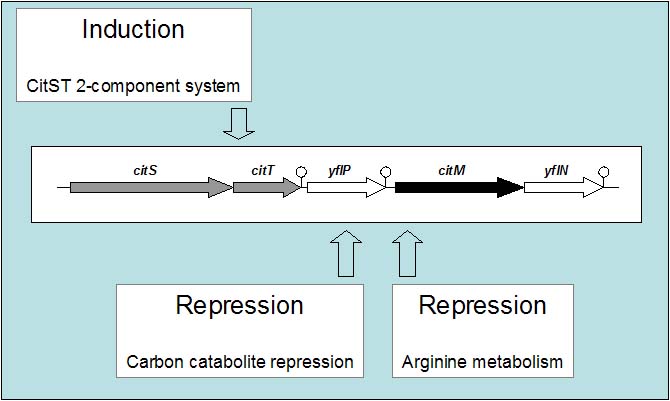Transporter physiology
• secondary proton motive force generation
• regulation of citrate metabolism in B. subtilis
The citrate transporter CitP and malate transporter MleP in the 2-hydroxy-carboxylate transporter (2HCT) family play a special role in the fermentation of these carboxylates by lactic acid bacteria. The transporters transport a wide range of compounds containing a 2-hydroxycarboxylate (2-HC) motif, HO-CR2-COO-. The citrate transporter CitP of the Leuconostoc mesenteroides and the malate transporter MleP of Lactococcus lactis function as precursor/product exchangers that catalyze the uptake of a substrate into the cell coupled to the exit of a metabolic end product. CitP catalyzes citrate/lactate exchange (citrolactic fermentation) and MleP malate/lactate exchange (malolactic fermentation). The pathways result in the generation of a proton motive force that is composed of a membrane potential generated by the transporters and a pH gradient by scalar proton consumption in the breakdown of the internalized substrates. Different bacteria use the pathways for different physiological purposes, which is reflected in the induction profile of the pathways. Citrate metabolism in heterofermentative Leuconostoc mesenteroides mainly serves the generation proton motive force and the pathway is induced in the presence of citrate. In L. lactis, the same pathway relieves lactate stress at low pH and the pathway is induced at low medium pH.
Similar pathways are involved in the production of biogenic amines by the decarboxylation of amino acid precursor (tyramine from tyrosine and histamine from histidine).
The genome of B. subtilis encodes 3-4 potential citrate transporters, but only one of these is involved in the growth of the organism on citrate or iso-citrate. The transporter CitM transports citrate in complex with Mg2+ in to the cell, but Mg2+ may be replaced with the heavy metals Zn2+ , Mn2+, Co2+, or Ni2+. Expression of CitM is under strict control of the medium composition. While the presence of citrate in the medium is essential to induce expression of CitM by a two-component signal transduction system, other factors like for instance glucose, completely repress citM expression by catabolite repression. In addition to glucose, repression is also observed in media containing glycerol, inositol, or succinate/glutamate. In rich media containing citrate, citM expression is repressed during the transition between the exponential and stationary growth phases by arginine metabolism. Arginine-mediated repression was independent of a functional CcpA, the global regulator protein in carbon catabolite repression.

| Last modified: | 14 May 2019 2.27 p.m. |
